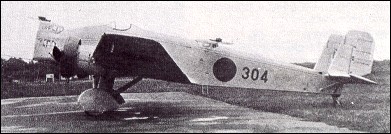 |
Mitsubishi Ki-21933 |  |
| BOMBER | Virtual Aircraft Museum / Japan / Mitsubishi |
 |
A most successful design, although built only in limited numbers, the Mitsubishi Ki-2 light bomber was developed from the Junkers K 37, an example of which had been imported from Germany in 1931 and donated by public subscription to the Japanese army. It bore the distinction of being 'Aikoku 1', the first of many such patriotic gifts, sparked off by the fighting in Manchuria. A three-seat cantilever low-wing monoplane, powered by two 425kW Nakajima Kotobuki radials, the Ki-2 prototype flew for the first time in the spring of 1933. It was distinguished easily by its corrugated metal alloy decking and twin fins and rudders, and had fixed divided landing gear, with spat-type main wheel fairings often discarded on service aircraft. Production of the initial version totalled 113, and the type went into operation against the Chinese with great success under the designation Ki-2-l or Army Type 93 Twin-engined Light Bomber. Maximum speed was 225km/h, normal range 900km and maximum take-off weight 4550kg. Single 7.7mm machine-guns were mounted in a semi-enclosed nose cockpit and a dorsal position, and maximum bombload was 500kg. The achievements of the Ki-2-l led to the development of the Ki-2-ll, or Army Type 93-2 Twin-engined Light Bomber, the Type 93 then being redesignated retrospectively as the Type 93-1. The Type 93-2 retained the same general configuration, but had a fully-enclosed manually-operated nose turret, an enclosed cockpit for the pilot, and main landing gear legs which semi-retracted forward into the engine nacelles. The Ki-2-ll had two 559kW Ha-8 radials giving much improved overall performance with maximum speed increased to 283km/h. In total 61 Ki-2-l Is were built, and these joined the Ki-2-ls in operations against the Japanese. Both versions ended their flying careers in the training role. A civilianised version of the Ki-2-ll named Otori (phoenix) was bought by the Asahi Shimbun newspaper and made a number of long-range record-breaking and 'goodwill' flights from 1936 to 1939. Registered J-BAAE, it covered the 4930km from Tachikawa military air base to Bangkok in 21 hours 36 minutes flying time in December 1936, and in early 1939 achieved a round-China flight of some 9300km.
|  COMPANY PROFILE | |||||||||||||||||||||||||||||||||||
 |

|
